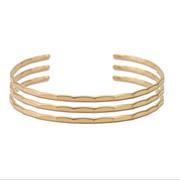Shopping for gold jewelry can be fraught - once you find that perfect piece that makes you feel wonderful, you might wear it only a few times before it irritates your skin, before the plating starts to wear off, or before it tarnishes and is unrecognizable. Here's a quick primer of the types of metal used in gold and "gold" jewelry.
Brass
Brass, bronze, and similar lower value alloys come in a range of colors. Brass can be polished to a bright yellow, though it oxidizes easily and tends turns orange or brown when worn. Bronze, on the other hand, has an antiqued color to it, and is frequently paired with a wide range of patinas that can change its color from antiqued gold to greens and blues. Since patinas are a result of a chemical reaction, whether with the air alone or additional substances, that reaction will slowly continue and the patina will change over time if not sealed. Love a patina? Ask about how it's protected.
Gold plate
Gold plated jewelry usually has a brass base with a very, very thin layer of gold on top. This keeps costs low, while giving the appearance of real gold. The trouble, of course, comes when the gold layer is rubbed and worn, slowly wearing it thin or encouraging it to peel off if it wasn't done well originally, and I find that it wasn't done well rather regularly. Gold plate can be great if you're pretty easy on your jewelry and don't have any known metal allergies. For me, I would be fine with gold plated earrings, so long as the earring backs are good enough in quality - earrings don't rub a lot on my skin as I wear them, so the gold plate is likely to stay exactly where it is for a long time. On the other hand, a gold plated ring would be TERRIBLE for me because I work with my hands and tend to fidget with my rings - bad habit! I could wear off a gold plate layer on a ring within a day if it's thin enough. Bracelets also tend to get more wear, whereas necklaces tend to get a little less.
Gold plate is good for those without allergies, because the is definitely a risk that the gold will wear thin and the lower metal will be exposed. For some people, their skin is more acidic and tends to eat away at jewelry or turn colors more easily when wearing jewelry. For those people, I would not recommend gold plate, as it tends to get pocked and removed quickly.
Gold fill, gold filled, rolled gold
Gold fill has been gaining momentum in the past decade or so, as the popularity of gold has risen with the price. Gold fill is like gold plate because it's a layer of gold on top of a similarly colored metal base, but it's different from gold plate because it's a MUCH thicker layer. Gold fill is up to hundreds of times thicker than gold plate, so it wears very well over time - ALMOST like solid gold. The key differences is that gold fill tends to be just a little less bright than solid gold; gold fill tends to only appear in 14K, and on occasion, 12K; and gold fill pieces may have spots of the metal base that are still exposed, depending on how they are made. If you have allergies, I recommend talking to the maker. If you're buying from someone who is stocking or reselling the jewelry for the maker, keep in mind that they are not likely to have this information.
Solid gold
I almost typed that this is the gold standard of gold jewelry, but then I realized the terrible pun I was about to unleash IN EARNEST on you, and resorted to awkwardly telling on myself instead. Win/win? Solid gold jewelry is heriloom quality - it will last generations, can be repaired, and will retain a certain amount of its value solely for the resale value of the gold. Solid gold is readily available in 10, 14, 18, 22, and 24K, meaning that the mix of metals to create the gold contains a range of 41% gold in 10K, 58% in 14K, and is 100% gold in 14K. Gold is a surprisingly soft metal, which is why it usually appears in a mix of metals - it ensures that the jewelry will not be too easily damaged over time as it is pressed, scraped, and rubbed against harder metals. While 24K will be dazzlingly bright and beautiful, it is soft enough that 14K and 18K reign as the most used gold alloys for jewelry - they're hard enough and still bright enough to be a very good balance for daily wear.
A note for those with allergies and acidic skin
My favorite trick for protecting both you and your jewelry is to paint the parts of your jewelry that touch your skin with a thin layer of clear nail polish (jeweler's varnish if I'm doing it for you in the shop, though they're remarkably similar). The layer needs to be replaced regularly, but will reduce allergic irritation and damage to the metal if your skin is reactive/acidic. That said, I only recommend experimenting with this for mild, well known allergies, not the anaphylactic shock varieties. You know, use caution and all that.








